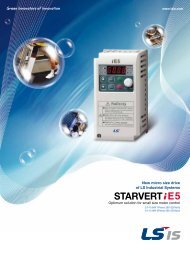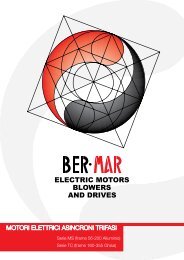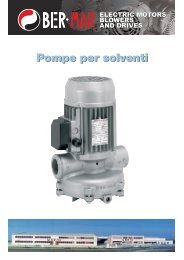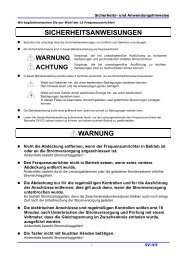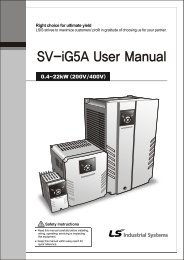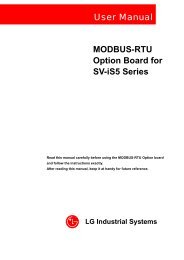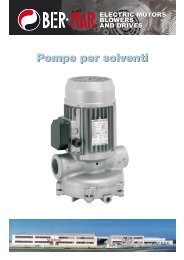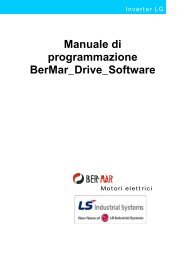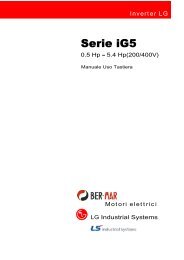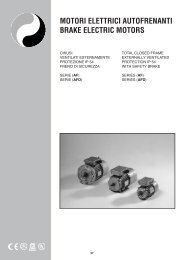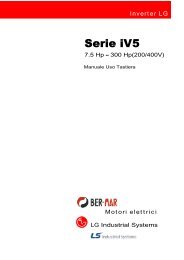Motori Asincroni Vettoriali - Bermar.it
Motori Asincroni Vettoriali - Bermar.it
Motori Asincroni Vettoriali - Bermar.it
You also want an ePaper? Increase the reach of your titles
YUMPU automatically turns print PDFs into web optimized ePapers that Google loves.
DIAGRAMMI CARATTERISTICI DI FUNZIONAMENTO DEI MOTORI SINCRONI AR<br />
CHARACTERISTIC OPERATION DIAGRAMS OF THE “ AR” SYNCHRONOUS MOTORS<br />
Coppia in servizio continuo<br />
con ventilazione forzata<br />
o con servizio interm<strong>it</strong>tente del motore<br />
Torque in continuos duty<br />
w<strong>it</strong>h interm<strong>it</strong>tent duty<br />
off the motor<br />
Dal diagramma sopra esposto si ricava che, effettuando<br />
una regolazione proporzionale tensione frequenza da<br />
zero fino a quella nominale del motore, questo funziona a<br />
coppia costante con veloc<strong>it</strong>à e potenza proporzionali alla<br />
frequenza. Osservando l’andamento della coppia si nota<br />
una diminuzione della stessa a bassi giri. Questo fenomento<br />
si verifica a basse frequenze perchè si riduce la<br />
reattanza rotorica, mentre aumenta la caduta di tensione<br />
primaria; ne consegue una diminuzione del flusso e della<br />
coppia. Pertanto volendo mantenere la coppia a valori<br />
accettabili è necessario alimentare il motore con una tensione<br />
più elevata. Nel caso di frequenze superiori a quella<br />
nominale non é possibile aumentare ulteriormente la tensione<br />
perchè le perd<strong>it</strong>e nel ferro aumenterebbero in modo<br />
intollerabile. Di conseguenza all’aumentare della frequenza<br />
con tensione costante si ha una riduzione del flusso<br />
magnetico e pertanto della coppia: il motore in questo<br />
caso funziona a veloc<strong>it</strong>à variabile e potenza costante. Va<br />
inoltre osservato che a basse veloc<strong>it</strong>à il motore lavora in<br />
gravose condizioni termiche essendo ridotto notevolmente<br />
l’effetto autoventilante. Si consiglia pertanto un servizio<br />
interm<strong>it</strong>tente o lim<strong>it</strong>ato oppure una ventilazione assist<strong>it</strong>a<br />
nel caso di un servizio continuo. Ventilazione assist<strong>it</strong>a che<br />
consigliamo anche nel caso di funzionamento alle alte<br />
veloc<strong>it</strong>à poichè in questa s<strong>it</strong>uazione la ventilazione necessaria<br />
assorbe un apotenza pari al cubo della veloc<strong>it</strong>à stessa<br />
il che potrebbe ridurre il rendimento del motore stesso.<br />
From the above diagram <strong>it</strong> results that, by carring out a<br />
proportional regulation between frequency and voltage<br />
starting from zero until the rated frequency of the motor,<br />
this runs at constant torque w<strong>it</strong>h speed and power proportional<br />
to the frequency. By observing the trend of the torque<br />
you may notice a decrease of the same one at a low<br />
number of revolutions. This phenomena occurs at low frequencies,<br />
because the rotor reactance is reduced, while<br />
the primary voltage drop increase; this causes a decrease<br />
of the flux and of the torque. Therefore in order to keep<br />
the torque at acceptable values, <strong>it</strong> is necessary to feed the<br />
motor w<strong>it</strong>h a higher voltage. In case of frequencies higher<br />
than the rated frequency, <strong>it</strong> is not possible to further<br />
increase the voltage because the iron losses would<br />
increase too much. Therefore as the frequency increase<br />
w<strong>it</strong>h constant voltage, the magnetic flux decrease and therefore<br />
also the torque decreases; in this case the motor<br />
runs at variable speed and at constant power. You should<br />
notice, moreover, that at low speeds the motor runs under<br />
severe thermal cond<strong>it</strong>ions due to the fact that the selfventilating<br />
effect is considerably reduced. We suggest therefore<br />
e<strong>it</strong>her an interm<strong>it</strong>tent or lim<strong>it</strong>ed duty or an assisted<br />
ventilation in case of a continuous duty. We suggest an<br />
assisted ventilation also in case of running at high speeds<br />
because in this s<strong>it</strong>uation the necessary ventilation absorbs<br />
a power equal to the cube of the speed <strong>it</strong>self, and this<br />
could reduce the yield of the motor considerably.<br />
113



